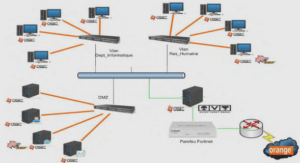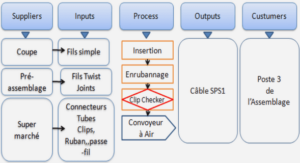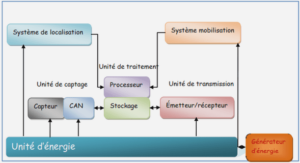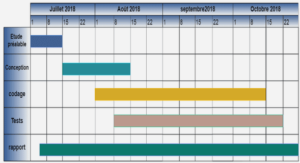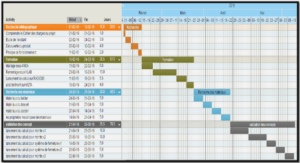Sea-ice and surface water assemblages
ENRICHMENT OF NUTRIENTS AND MICROORGANISMS IN NEWL y FORMED SEA ICE ON THE MACKENZIE SHELF: SIGNIFICANCE OF HETEROTROPHIC REGENERATION AND EXOPOLYMERIC SUBSTANCES :
La glace de mer nouvellement formée a été échantillonnée à 32 stations réparties sur le plateau continental du Mackenzie, entre le 30 septembre et le 10 novembre 2003. À chaque station, des échantillons de glace de mer et d’eau de surface ont été prélevés afin de déterminer les concentrations et l’enrichissement en nutriments, en substances exopolymériques (EPS, mesurés avec du bleu Alcian), en chlorophylle a (chI a), en protistes autotrophes et hétérotrophes, ainsi qu’en bactéries hétérotrophes. Des incubations au noir ont été menées afin d’estimer les taux de régénération nette par les hétérotrophes, dans la glace d’une épaisseur < 5 cm. Nos résultats montrent que les protistes autotrophes de grande taille (~ 5 ~m) sont enrichis de façon sélective au cours de la formation de la glace et présentent l’ indice d’ enrichissement le plus élevé (Is = 62), bien que les protistes hétérotrophes (Is = 19), les EPS (Is = 17), les bactéries (Is = 6), et les nutriments azotés (ls = 3 à 5) soient aussi enrichis dans la glace de mer. Des relations significatives ont été observées entre les concentrations en EPS et celles en chI a totale dans la glace (r = 0.59, P < 0.001) et entre les indices d’enrichissement des EPS et des protistes autotrophes (r = 0.48, P < 0.01), ce qui suggère que les EPS sont produits par les algues incorporées dans la glace. Ces résultats indiquent aussi que la présence des EPS favoriserait l’enrichissement sélectif des protistes autotrophes de grande taille. La régénération par les hétérotrophes a contribué à l’enrichissement du NH4 dans la glace, avec un taux de régénération moyen de 0.48 ~M N d· l , et en contribuant 67 % des concentrations en NH4 mesurées dans la glace. La régénération en NH4 était aussi couplée à la consommation de Si(OH)4 et corrélée de façon significative avec les concentrations en EPS dans la glace. Nos résultats suggèrent que les EPS favorisent la régénération du NH4 dans la glace, en procurant une source de carbone pour les protistes hétérotrophes et/ou un substrat pour les bactéries.
High biomasses of algae and other protists can accumulate in Arctic first-year sea ice in the spring (i.e. sea-ice al gal blooms in April-May, Smith and Herman 1991, Michel et al. 1996, Melnikov et al. 2002). However, algal cells and other microorganisms are present within the sea ice for several months prior to the beginning of the spring bloom (Gradinger & lkiivalko 1998, Melnikov et al. 2002). Microorganisms from the water column and ev en the benthos are incorporated in the sea ice during its formation, which occurs primarily between September and December on the Canadian Arctic shelves (Canadian ice services 2002). Organisms incorporated in the sea ice during the fall can overwinter in the sea-ice matrix and are the founding members of the spring bloom community (Zhang et al. 1998).
In the Arctic Ocean, suspension freezing (Campbell & Collin 1958) is the most important process for the accumulation of inorganic sediments within the sea ice (Reimnitz et al. 1992). This same process leads to the accumulation ofmicroorganisms in newly formed sea ice (Garrison et al. 1983, Reimnitz et al. 1993). Suspension freezing occurs under cold turbulent conditions which can lead to a supercooled water column. Once supercooled, frazil sea ice (i.e. suspended ice crystals) forms in the water column and rises to the surface where it accumulates as new ice with columnar ice growth continuing after frazil formation ends (Weeks & Ackley 1982, Eicken 2003).
Inorganic sediments and microorganisms can adhere to individual frazil crystals as they rise through the water column. Frazil fonnation may occur as deep as 25-30 m so that small particles can be picked up directly from the benthos on shallow shelves (Reimnitz et al. 1992). Large quantities of sediment and benthic microorganisms can also be incorporated into newly fonned sea ice when frazil adheres to coarse particles on the sea-floor fonning unconsolidated masses of anchor ice (Reimnitz et al. 1992). Under calm conditions the anchor ice, along with entrapped particles, can float to the surface and become incorporated into the newly fonned sea ice. The fonnation of anchor ice and deep frazil can explain the numerous benthic algal species found in Arctic sea ice during the spring bloom (von Quillfeldt et al. 2003).
Acknowledgements:
This project was supported by grants from the Natural Sciences and Engineering Research Council (NSERC) of Canada (Research Network grant to C.M and M.G.; Individual and Northern Research Supplement Discovery grants to M.G.) and from the Department of Fisheries and Oceans (DFO) Academic Science Subvention Pro gram to M.G. and C.M., and Science Strategic Fund to C.M. Partial operating funds for the CCGS Amundsen were provided by the International Joint Ventures Fund of the Canada Foundation for Innovation and the Fonds québécois de la recherche sur la nature et les technologies (FQRNT). A.R. received post-graduate scholarships from NSERC, UQAR, the Fondation de l’UQAR (bourse Estelle-Laberge) and the Institut des sciences de la mer de Rimouski (ISMER), and financial support from Indian and Northern Affairs Canada for fieldwork. We sincerely thank the officers and crew of the CCGS Amundsen for their support ofthis research expedition; M. Poulin for assisting in the field and laboratory; and J .É. Tremblay and K. Simpson for conducting the nutrient analysis. This is a contribution to the research programs of the Canadian Arctic ShelfExchange Study (CASES), the Freshwater Institute (Fisheries and Oceans Canada), ISMER and Québec-Océan.
EVIDENCE OF AN ACTIVE MICROBIAL FOOD WEB IN SEA ICE AND SURFACE WATERS ON THE MACKENZIE SHELF (CANADIAN ARCTIC) DURING THE WINTER-SPRING TRANSITION:
La dynamique des bactéries hétérotrophes a été étudiée dans la glace de mer et les eaux de surface du plateau du Mackenzie (mer de Beaufort), entre le 5 mars et le 3 mai 2004. À 12 occasions, le broutage par les protistes hétérotrophes sur les bactéries a été mesuré suivant la méthode de disparition de bactéries fluorescentes (fluorescently labeled bacteria) sur des échantillons de glace prélevés sous couvert de neige épais et mince, ainsi que sur des échantillons d’eau de surface. Concurremment, des échantillons de glace et d’eau de surface ont été analysés afin de mesurer les concentrations en carbone organique dissous (DOC), en substances exopolymériques (EPS), et en chlorophylle a (chi a), ainsi que l’abondance des protistes et des bactéries. L’abondance totale des bactéries était plus élevée dans la glace de mer que dans l’eau de surface (p < 0.05). Toutefois, les concentrations en DOC et l’abondance des grosses bactéries (20.7 !lm) n’étaient pas statistiquement différentes entre la glace et l’eau de surface (p > 0.20). Le broutage par les hétérotrophes (HP) sur les bactéries représentait en moyenne, 27 % et 35 % de la biomasse bactérienne dans la glace, sous couvert de neige épais et mince, respectivement, et 29 % de cette biomasse dans les eaux de surface. Dans la glace, les taux d’ ingestion de la communauté étaient, en moyenne, de 1.9 et 1.7 x 103 bactéries HPI dI , sous couvert de neige épais et mince, respectivement. Il semble que les fortes concentrations en EPS pendant la période de floraison des algues de glace auraient pu interférer avec l’activité de broutage des protistes hététrotrophes, tel qu’indiqué par les corrélations négatives entre les taux d’ingestion des hétérotrophes >5 !lm et les concentrations en EPS (T = -0.46 P < 0.01). Dans les eaux de surface, les taux d’ingestion par la communauté hétérotrophe étaient élevés, en moyenne 7.1 x 103 bacteria HPI dI , et ce possiblement en raison de la présence de protistes mixotrophes. Le broutage sur les bactéries était suffisant pour combler les besoins en carbone des hétérotrophes ::::5 !lm, ce qui n’était pas le cas pour les hétérotrophes >5 !lm pendant la période de floraison des algues de glace. Les EPS pourraient constituer une source alternative de carbone pour ces derniers, particulièrement pendant la période de floraison des algues de glace. Cette étude met en évidence la présence d’ un réseau microbien hétérotrophe actif dans la glace de mer annuelle, pendant la période précédant, ainsi qu’au cours de la période de floraison des algues de glace. Cette étude met aussi de l’avant l’importance du DOC et des EPS en tant que composantes intégrales du réseau microbien dans la glace de mer et les eaux de surface du plateau continental arctique.
At the high and low snow coyer sampling sites, multiple cores were collected for routine measurement of DOC, exopolymeric substances (EPS), chlorophyll a (chI a), protist and bacterial abundances, and for fluorescently labeled bacteria (FLB) grazing experiments. The bottom 4 cm of three to five ice cores was pooled together in an isothermal container, to obtain one sample for each snow coyer depth. Sterile g]oves were worn at a11 times during the manipulation of the cores. On each sampling day, water from the ice-water interface was also collected using a hand pump. One subsample of this surface water was analyzed for DOC, EPS, chI a and cells, a second was used for FLB grazing experiments and a third subsample was filtered on polycarbonate 0.2 ~m filters and added to the ice core sampI es to minimize osmotic stress during the melting process (Garrison & Buck 1986). A separate ice core, kept in a sterile Wbirl-Pak bag, was melted without the addition of filtered surface water for the analysis of sea-ice DOC. When necessary, sea-ice concentrations ofmeasured variables and experimental results were corrected for the dilution from the addition of seawater during the melting process.
Grazing rates:
Significant linear decreases in FLB concentrations were observed over the entire incubation period for aIl grazing experiments except under high snow·cover on 28 April. In this one experiment, a linear decrease was observed during the first 10 h of the experiment, with no further decrease for the remainder of the 48 h experiment. The result ofthis experiment was excluded from our dataset. For aIl grazing experiments, the regression coefficients (i.e. s]opes) were significantly different from zero (p < 0.05).
Discussion:
Arctic sea ice appears to be a favorable growth environment for heterotrophic bacteria, as compared to the pelagic, as indicated by high bacterial abundances and large cell sizes observed in this study. Bacterial abundances in the sea ice on the Mackenzie shelf were within the range previously observed for Antarctic (Growing et al. 2004 and references therein) and Arctic sea ice (Bunch & Harland 1990, Gradinger & Zhang 1997). Bacterial abundances from the ice-water interface were also comparable with previous estimates for surface waters in the same are a (Garneau et al. 2006).
Grazing rates:
Community grazing rates, estimated by the disappearance of FLB in this study, are high in comparison to published results from other marine systems (e.g. Arctic Ocean, Sherr et al. 1997). Changes in environmental structure (i.e. ice brine channels versus melted sampI es) or salinity may have enhanced grazing rates in melted samples. The addition of FLB may have also enhanced grazing since larger prey can be preferentially selected and stimulate protistan grazing (Andersson et al. 1986). However, the average size of FLB (1.8 !lm) added was similar to the average size of observed bacteria (1.1 !lm) in the sea-ice samples. The FLB were also added in tracer concentrations (average 12% of natural sea-ice bacterial abundances) in order to limit the stimulation of grazing activity (McManus & Okubo 1991). Non-grazing losses ofFLB would have also resulted in an overestimation of FLB disappearance. Losses which could be taken into consideration include viral lysis, abiotic FLB breakdown and the attachment of FLB to particles.
SEASONAL STUDY OF SEA-ICE EXOPOLYMERIC SUBSTANCES ON THE MACKENZIE SHELF: IMPLICA TIONS FOR THE TRANSPORT OF SEA-ICE BACTERIA AND ALGAE :
Des échantillons provenant de la couche inférieure de la glace de mer, à deux sites représentatifs d’un couvert de neige mince et épais, ainsi que d’eau de surface, ont été prélevés à 21 occasions, entre le 24 février et le 20 juin 2004, dans la baie de Franklin (plateau continental du Mackenzie). Ces échantillons ont été traités pour analyse des substances exopolymériques (EPS), du carbone organique particulaire (POC) et de la chlorophylle a (chI a). Les concentrations en EPS ont été mesurées sur des échantillons de glace fondue, suite à une coloration au bleu Alcian. Les vitesses de chute de la chI a et des bactéries ont aussi été évaluées en utilisant des colonnes à sédimentation, afin de déterminer le rôle potentiel des EPS sur le transport de la biomasse associée à la glace. Les concentrations en EPS dans la couche inférieure de la glace étaient faibles au cours du mois de mars (moyenne de 185 Ilg xeq. 1 -1 ) et ont augmenté par la suite, pour atteindre des valeurs maximales de 4930 et 10500 Ilg xeq. 1 – 1 sous couvert de neige épais et mince, respectivement. Les concentrations en EPS dans les eaux de surface se sont maintenues à des valeurs de deux ordres de magnitude plus faibles que celles observées dans la glace. Dans la glace, les concentrations en EPS étaient corrélées de façon significative avec les concentrations en chI a (T = 0.70, P < 0.01). Les algues de glace étaient principalement responsables de la production de EPS dans la glace; la contribution des bactéries à cette production était mineure. Le carbone associé aux EPS contribuait, en moyenne, à 23 % des concentrations en POC dans la glace, avec une valeur maximale de 73 % au cours de la période de fonte. Les vitesses de chute médianes de la chI a étaient de 0.11 et 0.44 m dI sous couvert de neige épais et mince, respectivement. Aucun effet significatif des EPS sur les vitesses de chute de la chI a n’a été démontré. Toutefois, les vitesses de chute des bactéries auraient été influencées par la présence de EPS, soit en association avec des diatomées, ou comme particules libres dans la glace. La présence de EPS sur les diatomées favoriserait l’ attachement des bactéries sur les algues, et augmenterait ainsi les vitesses de chute des bactéries, alors que les vitesses de chute de bactéries associées avec des particules libres de EPS, dont la flotabilité est positive, seraient réduites. Les substances exopolymériques contribuent de façon significative à la biomasse en carbone dans la glace de mer, et influencent la sédimentation de cette biomasse. Ces résultats mettent en évidence l’ importance du rôle des EPS dans le cycle du carbone sur le plateau continental arctique.
Bottom sea ice, from under high and low snow cover, and surface water samples were collected in Franklin Bay (Mackenzie shelf) on 21 occasions between 24 February and 20 June 2004 and analyzed for exopolymeric substances (EPS), particulate organic carbon (POC) and chlorophyll a (chI a). Concentrations of EPS were measured using Alcian blue staining of melted ice samples. Chlorophyll a and bacterial sinking velocities were also assessed with settling columns, to determine the potential role of EPS in the transport of sea-ice biomass. Concentrations of EPS in the bottom ice were consistently low in March (avg. 185 flg xeq. 1 -1), after which they increased to maximum values of 4930 and 10500 flg xeq. ri under high and low snow cover, respectively. Concentrations of EPS in the surface water were consistently two orders of magnitude lower th an in the sea ice. Sea ice EPS concentrations were significantly correlated with sea-ice chi a biomass Cr = 0.70, P < 0.01). Sea-ice algae were primarily responsible for EPS production within the sea ice, whereas bacteria produced insignificant amounts of sea-ice EPS. EPS-carbon contributed, on average, 23% of POC concentrations within the sea ice, with maximum values reaching 72% during the melt period. Median chi a sinking velocities were 0.11 and 0.44 m d-I under high and low snow co ver, respectively. Exopolymeric substances had little effect on chi a sinking velocities. However, bacterial sinking velocities did appear to be influenced by diatom-associated and free EPS within the sea ice. Diatom-associated EPS could facilitate the attachment of bacteria to algae thereby increasing bacterial sinking velocities, whereas the sinking velocities of bacteria associated with positively buoyant, free EPS, could be reduced. Exopolymeric substances contributed significantly to the sea-ice carbon pool and influenced the sedimentation of sea-ice biomass, which emphasizes the important role of EPS in carbon cyc1ing on Arctic shelves.
In pelagic systems, exopolymeric substances in the form of TEP have been recognized as a key component of the carbon cycle, directly contributing to the carbon pool and influencing sedimentation and small-scale microbial processes such as nutrient uptake and bacterial productivity (see Passow 2002a). Previous studies of first-year pack ice in Antarctica (Meiners et al. 2004) and first-year, landfast and pack ice in the Arctic (Krembs & Engle 2001, Krembs et al. 2002, Meiners et al. 2003) have found high concentrations of EPS in the interior and bottom of the sea ice. The current study found EPS to be a significant contributor to sea-ice carbon on Canadian Arctic shelves, with concentrations reflecting spatial and temporal variations in the sea-ice community. Key relationships were identified between EPS, chI a and bacteria, showing that EPS can influence carbon cycling within the sea ice and upon the release of sea-ice biomass into the water column at the time ofice melt.
Altematively, if EPS were exported from the sea ice at the same rate as particulate organic material, the high EPS:chl a and EPS-carbon:POC ratios observed at the end of the season would only be explained by increased in situ EPS production. Under-ice sediment traps adjacent to our sampling station confirmed that sea-ice algae, which were mainly diatoms at the peak of the sea-ice algal bloom, were being released from the sea ice at the time of ice melt (T. Juul-Pedersen pers. comm.). This confirms that the low sea-ice chI a concentrations observed at the end of season represented a reduced abundance of diatoms rather than a decrease in the chI a content of algal cells. Assuming limited EPS production by bacteria, as previously discussed, the remaining algal community on the last sampling day would have had to increase EPS production by, on average, 15 fold to produce the observed EPS concentration. Such increases in EPS production are unlikely. Increases of only 1.5 to 5 fold in diatom extracellular carbohydrate production have been reported due to nutrient or environmental stress (Urbani et al. 2005, Abdullahi et al. 2006). Therefore, we conclude that increased in situ production of EPS did not likely explain the high EPS-carbon:POC and EPS:chl a ratios observed at the end ofthe sampling period, suggesting that free EPS were retained within the melting sea ice. The EPS retained in the sea ice could supply a pulse of organic carbon into surface waters after the majority of sea-ice biomass has been released into the water column.
CONCLUSION GÉNÉRALE:
In this study, heterotrophic microorganisms and exopolymeric substances (EPS) in newly formed and first-year sea ice were shown to have multiple roles in the cycling of organic carbon on the Mackenzie shelf. An extensive seasonal characterization of heterotrophic bacterial and protist communities is provided, including the assessment of heterotrophic bacterivory and nutrient regeneration. This study was conducted on the Mackenzie shelf which represents a large area of first-year sea ice in the Arctic. The results presented here are generally applicable to sea-ice organic carbon cycling on the extensive circumpolar shelves and potentially new areas offirst-year sea-ice formation that could develop as a result of Arctic warming (Comiso 2002, 2003, Polyakov et al. 2003).
|
Table des matières
INTRODUCTION GÉNÉRALE
The changing Arctic
Arctic sea ice
Ecological role offirst-year sea ice
Heterotrophic microorganisms
ExopolYlners
Research objectives
CHAPITRE 1
ENRICHMENT OF NUTRIENTS AND MICROORGANISMS IN NEWL y FORMED SEA ICE ON THE MACKENZIE SHELF: SIGNIFICANCE OF HETEROTROPHIC REGENERATION AND EXOPOLYMERIC SUBSTANCES
RÉSUMÉ
ABSTRACT
Introduction
Materials and Methods
Sampling and analyses
Regeneration rates
Statistical analyses
Results
Physical and chemical environment
Sea-ice development and thickness
Sea-ice and surface water assemblages
Enrichment
Ammonium regeneration rates
Discussion
Sea-ice asselnblages
Sea-ice EPS
Enrichment and selectivity in newly fonned sea ice
Nutrient regeneration
Conclusions
Acknowledgelnents
CHAPITRE II
EVIDENCE OF AN ACTIVE MICROBIAL FOOD WEB IN SEA ICE AND SURFACE WATERS ON THE MACKENZIE SHELF (CANADIAN ARCTIC) DURING THE WINTER-SPRING TRANSITION
RÉSUMÉ
ABSTRACT
Introduction
Materials and Methods
Sampling and analyses
Chlorophyll a, EPS and DOC
Bacteri a and protists
FLB grazing experiments
Statistical analyses
Results
Experimental conditions
Grazing rates
Heterotrophic carbon requirements
Discussion
DOC and EPS
Grazing rates
Ingestion rates
Carbon sources for heterotrophic protists
Conclusions
Acknowledgelnents
CHAPITRE III
SEASONAL STUDY OF SEA-ICE EXOPOLYMERIC SUBSTANCES ON THE MACKENZIE SHELF: IMPLICATIONS FOR THE TRANSPORT OF SEA-ICE BACTERIA AND ALGAE
RÉSUMÉ
ABSTRACT
Introduction
Materials and Methods
Results
Spatial and seasonal trends
Sinking velocities
Discussion
Producers of EPS in sea ice
EPS seasonal dynamics
Biogeochemical roles of EPS in sea ice
Conclusions
Acknowledgetnents
CONCLUSION GÉNÉRALE
![]() Télécharger le rapport complet
Télécharger le rapport complet

